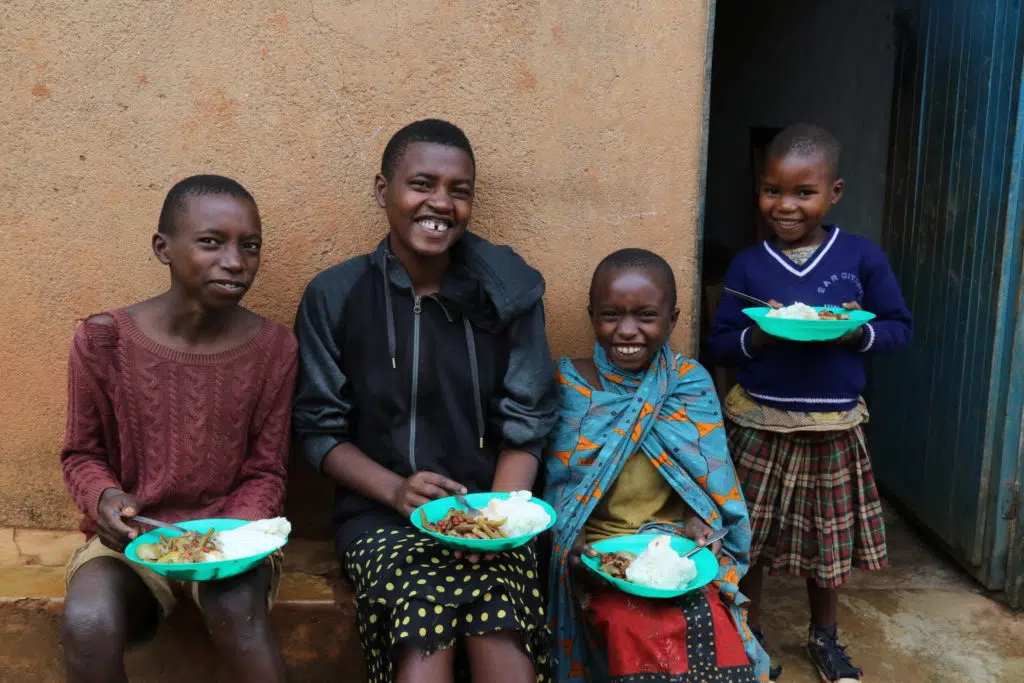Recently, with every new year it feels like we have been stuck in that TikTok trend, “hold my beer,” with each new year trying to top its predecessor and be more eventful than the last. And, as much as we wish it were different, 2022 is proving to be another difficult year. We continue to face stories of wars, conflict, natural disasters and the ongoing pandemic.
While many of us are fortunate enough to be disconnected from the majority of these events, for vulnerable and undernourished communities these emergencies can be devastating. Especially when it comes to hunger. When a disaster strikes it has long-term effects on hunger, whether it destroys food production, creates barriers to food distribution or causes inflation.
This month at Global Impact, we are focusing on hunger and how our partners increase access to food and support communities in times of disaster. Their support helps communities recover and become more resilient, prosperous and stable.
Here are five examples of how our charity partners fight hunger when crisis strikes:
Action Against Hunger: Supporting Afghanistan communities as they face multiple crises
Action Against Hunger has been dedicated to ending life-threating hunger for more than 40 years. They work in over 45 countries supporting communities by increasing their access to food, income and opportunities; improving the health of children and their families; providing basic needs when a disaster or emergency strikes and always looking for more effective solutions.
One of the countries in crisis they serve is Afghanistan. As a politically fractured and disaster-struck nation, Afghanistan has long faced challenges with widespread poverty and food insecurity. Action Against Hunger has worked in Afghanistan for two decades ensuring access to lifesaving services.
Currently, due to the impacts of COVID-19 and the Taliban takeover, Afghanistan is suffering from an extreme humanitarian crisis. They face a massive drought, conflict and economic collapse/extreme cash shortage. Families are experiencing unprecedented levels of hunger and malnutrition, with eight million people on the brink of famine. Action Against Hunger is on the ground providing nutrition and health services in remote areas, like Daykundi, where people are not able to reach health facilities. They provide these families with cash assistance to help them buy food and hygiene supplies. Their mobile teams travel to villages to screen and treat mothers, pregnant women and children for malnutrition.
Feed My Starving Children: Working with partners to distribute food and supplies to the Philippines
Feed My Starving Children (FMSC) brings hope to underserved communities by delivering millions of nutritious meals, packed with the help of volunteers, to undernourished people. They work with food distribution partners that stay with communities for the long haul and empower them to move from relief to development.
Southern Asia is one of the leading regions for children suffering from undernutrition. FMSC works with partners to send their MannaPack meals to people in need in eight countries across Asia, especially in the Philippines, which is consistently in the path of damaging typhoons. This recurring cycle of natural disasters has made it hard for the country to climb its way out of the damage left behind, leading to increased poverty and low food security.
In December 2021, the Philippines was hit by one of the deadliest disasters in the region, Super Typhoon Rai (known in the Philippines as Typhoon Odette). The islands were struck with torrential rain, violent winds, landslides and storm surges. More than 400 lives were lost, hundreds of thousands are homeless, and millions of livelihoods were thrown into jeopardy.
FMSC has been working with partners in the area to deliver lifesaving food and resources to communities where food sources were devastated and income streams were lost. Together they have delivered 4.6 million MannaPack meals. By providing these meals, FMSC has freed up their partners’ resources to be able to do more such as distributing clean water and rebuilding their homes and communities. Global Impact also launched a Super Typhoon Rai Relief Fund.
Heifer International: Supporting small-scale farmers in the US during COVID-19
Heifer International helps communities around the world fight hunger and end poverty. They start by providing a seed investment of livestock or agriculture, alongside guidance and mentorship to help individuals build a business and gain access to supply chains and markets. By working with farmers, ranchers and female business owners across the world, Heifer gives families and communities opportunities to earn living incomes and build more resilient futures.
COVID-19 disrupted food systems across the globe, including here in the U.S. While we were in lockdown, the pandemic revealed major gaps in our food system. We saw food banks face a shortage of supplies while farmers were forced to destroy their harvests.
Heifer USA, a flagship project of Heifer International, stepped in to support small-scale farmers and work with them to build a better system for both farmers and consumers. Heifer donated thousands of pounds of nutritious food to foodbanks, offered employment opportunities to food service workers who had lost their jobs, and integrated more small farms into their value-chain system. Following their traditional model, Heifer has supported small-scale farmers across the country helping them to deliver fresh, nutritious food, connect with reliable markets and provide training, education and resources to help them navigate the market and secure fair prices for their products.
Heifer USA delivers safely at home / Phillip Davis / Heifer International
Rise Against Hunger: Integrating environmental sustainability during times of a climate crisis
Through nourishing lives, empowering communities and responding to emergencies, Rise
Against Hunger is striving to make an impact on hunger for millions around the globe.
Climate change is one of the leading factors affecting hunger and impacts low-income communities most. An increase in natural disasters, unpredictable weather patterns and more extreme temperatures is disrupting our food systems, affecting harvests and planting seasons, and decreasing availability of produce and supplies. Ironically, the agricultural industry actually accounts for 70% of the world’s water usage and 24% of global greenhouse gas emissions. Not taking the environment into consideration when looking at food production and distribution models is harmful to the world, and especially, vulnerable communities.
Rise Against Hunger is working with partners and communities around the world to integrate environmentally sustainable practices into their food security projects. In India, Rise Against Hunger works with smallholder farmers in millet production, creating a more sustainable process. Millet, a climate-friendly and nutritious grain that requires little water, is an ideal product for the drought-ridden region, and they have been able to improve the soil by using organic fertilizer methods like composting with worms. In Mali, where much of the land is arid and desert, Rise Against Hunger works with their partner, Association Malienne d’Eveil au Développement, to train women and farmers on how to farm sustainably and manage their land. They learn water management practices, ways to reduce soil erosion, and tactics to protect their crops (like mulching and selecting sustainable seeds for crops).
Mali: Elevating Women & Youth Farmers / Rise Against Hunger
World Food Program USA: Supporting food systems in Ukraine and beyond
World Food Program USA is dedicated to building support within the U.S. for the United Nations World Food Programme (WFP), which brings life-saving food to people in 117 countries and territories recovering from conflict, disasters and the impact of climate change. Their work lays the foundation to more prosperous and stable futures for communities by supporting them in building resilience, adapting to climate change, promoting good nutrition, and improving food systems.
As the conflict in Ukraine unfolded, WFP launched emergency operations to provide food assistance for those affected, whether they have been forced to flee their homes and take refuge in neighboring countries or have been unable to evacuate and are forced to shelter in locations throughout the country. WFP teams are on the ground in Kyiv, Ukraine and neighboring countries leading the emergency efforts on behalf of the U.N. They have been able to reach 1.3 million people with emergency support and aim to reach six million over the next three months with food and cash assistance.
But the challenges continue to mount. In Ukraine, the current systems that have been feeding those still in the country have fallen apart, and local production is disrupted. Fuel shortages and scarcity of drivers and trucks are limiting the ability of farmers to deliver their produce to the markets. Major Ukraine ports, airports and railways have also been closed or are under threat, limiting activity.
Meanwhile, with the Black Sea region being one of the world’s most important areas for grain and agricultural production, the conflict will impact food security beyond Ukraine’s borders. WFP gets 50% of their grains out of the Ukraine-Russia area. These damages to the food systems will have a dramatic impact on food costs, shipping costs, oil and fuel, which will simultaneously increase operational costs for WFP, constraining its response at a time when people need it most . However , as it always has, WFP will be ready to step up to deliver lifesaving food to children and families around the world.
Feeling inspired? Be a part of the solution in ending world hunger! Here are a few ways you can join forces with our charity members and be a part of the global movement:
- Donate to our Hunger High Impact Fund to support these charities’ efforts.
- Give through your company’s workplace giving campaign.
- Gather your co-workers to pack lifesaving meals at an event with one of our charities. Contact us for more details!
- Use Global Impact’s Hunger Cause Kit to learn more about the cause with your friends, family or co-workers.






